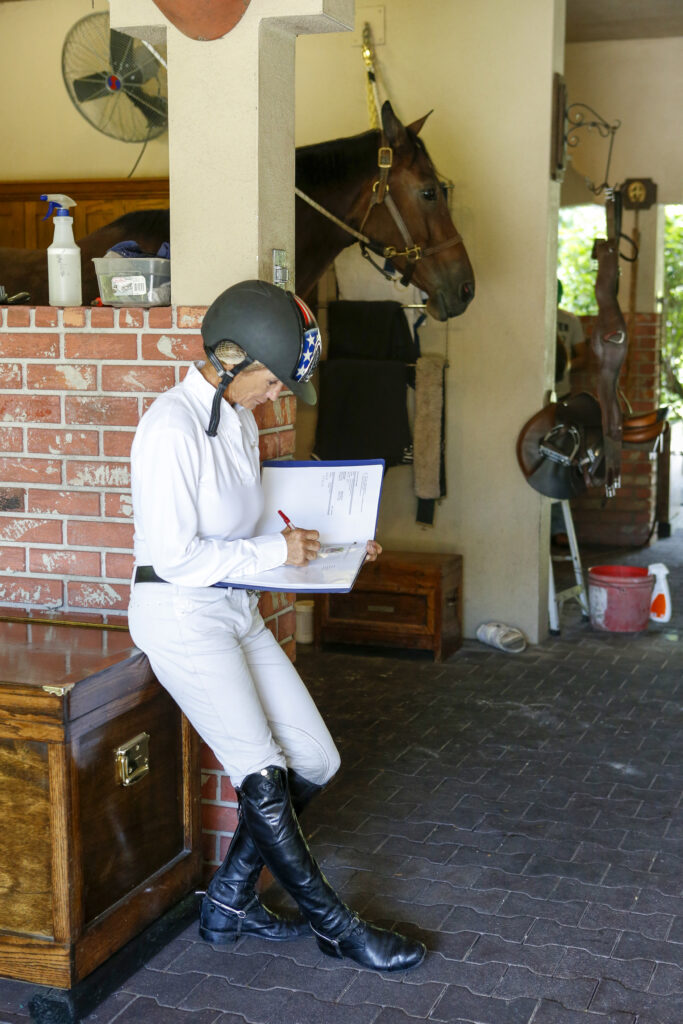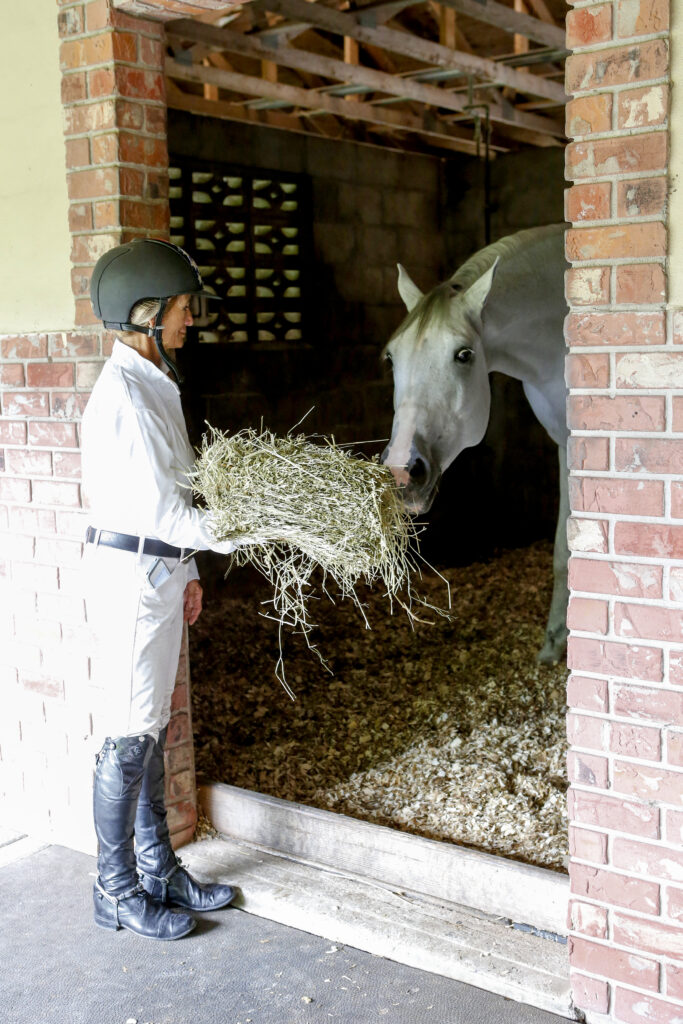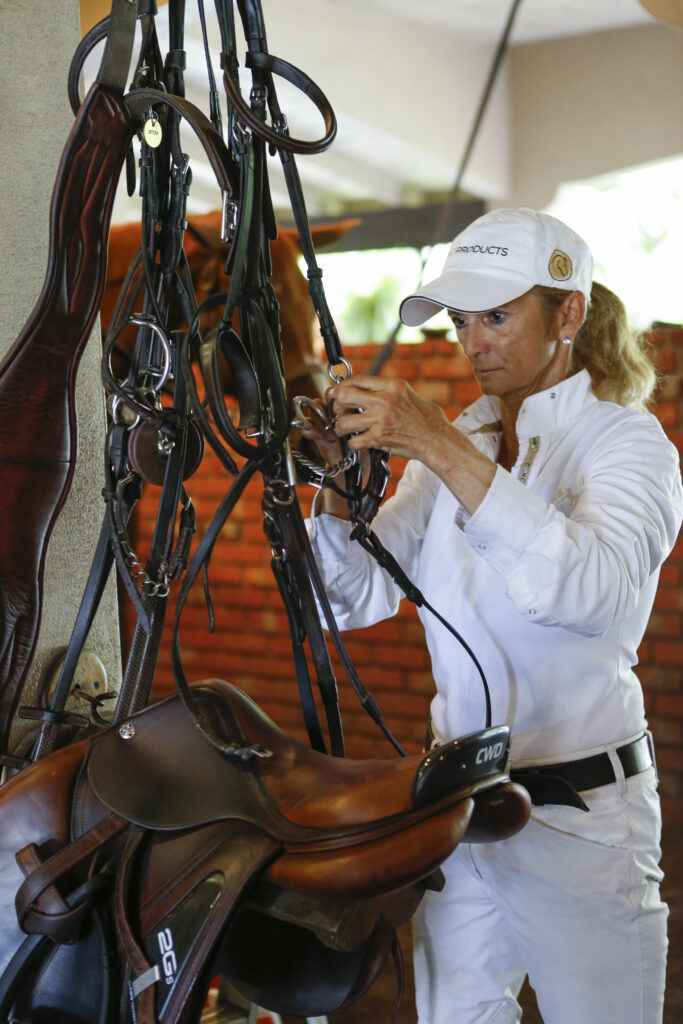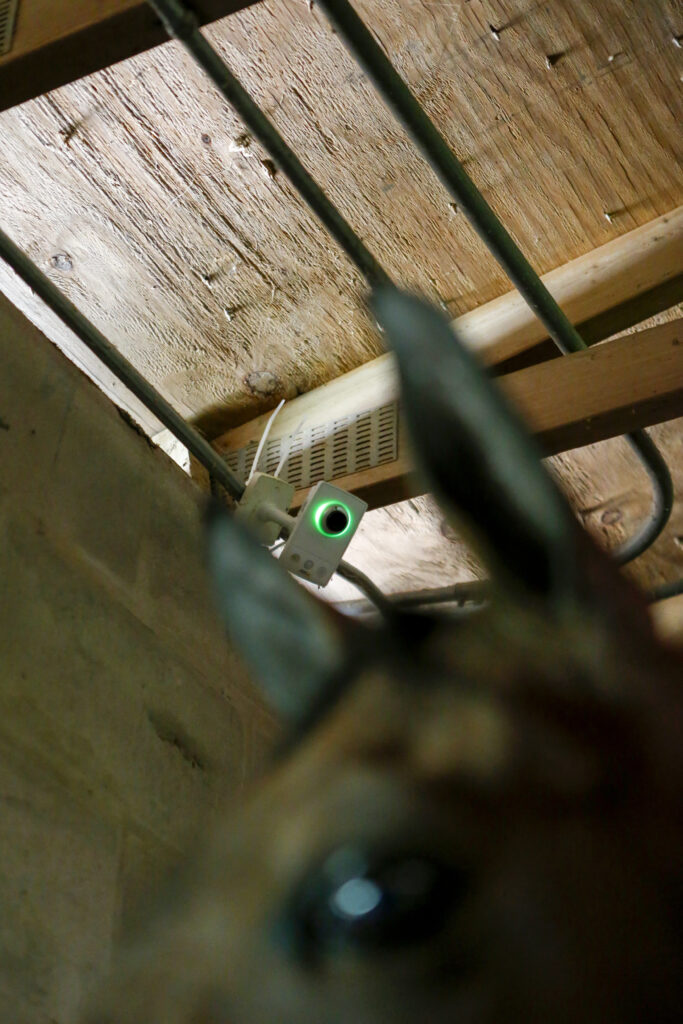Whether you compete or just ride for fun, you can raise your horsemanship to a higher level by learning more about your horse, your sport—and yourself. Successful riding is all about creating the best possible partnership with your horse. In this three-part series, I will tell you how to do that, both at home and at shows. This month, I’ll describe my methods for gathering and tracking all the pertinent information that might affect your horse’s health, happiness and performance. Next month, I’ll describe my strategy for preparing both your horse and yourself for competition. The following month, I’ll share some helpful tips for focusing your mind and arriving at the ring ready to ride your best—every time.

There’s No “I” in Team
The better you know your horse, the better you can perform together as a team—no matter what level you are. Riding is like pairs figure skating, only much harder since our horses can’t talk. We love them so much, but we can’t ask what they’re thinking or how they’re feeling. Instead, to develop the same kind of fluid, connected partnership that a pair of skaters demonstrates on the ice, you have to compile as much information about your horse as you can. By learning his history, monitoring his daily routine and tracking his health, behavior and performance, you can learn to predict what methods will and won’t work for him in the future. Keeping a record book is one of the most powerful tools for getting to know your horse inside and out. Sometimes the tiniest details, such as a minor cough or thrown shoe, can lead to major changes in his performance. We all think we’ll remember these details later, but we usually don’t—especially if the cause and effect span a long period of time. With good records to look back on, you’ll be surprised at how much you learn about your horse.
Even if your horse is in a full-care facility, get involved in his daily care. In addition to maintaining a record book, keep a diary and checklist like the ones I describe below and research every unfamiliar horse-related topic you come across. Most importantly, ask questions of the people helping you care for your horse, whether it’s your trainer, a barn manager, your farrier—not in a confrontational or accusatory way but always with the express purpose of better informing yourself. As the saying goes, the best consumer is an educated consumer.
Tap into today’s technology, too. Anybody from age 8 to 80 can find useful resources on the Internet. If you’re on the latter end of that spectrum, ask your grandkids for help. I Google anything I don’t know. Be sure to stick to reputable sources, like sport/breed organizations, veterinary schools and extension services. You can also go to www.PracticalHorsemanMag.com for reliable info on most horse-related topics. I also take advantage of high-tech devices and software solutions that can help me monitor my horses.


The Record Book
Create your record book out of a regular binder, with section dividers and added clear sleeves for storing important documents, and even documents that may seem nonessential but might be useful later. Make the following sections:
1.Your horse’s history. Fill this section with everything you know about your horse’s basic physical characteristics and life to date: age, sex, height, color, markings, breed, original name, lineage, date acquired, name and contact info of previous owner(s), past performances, etc. If you don’t know much about your horse’s past, try searching for his name (or tattoo or brand, if he has one) online. Many breed and sport organizations now have searchable databases available to the public. If your horse is imported from Europe, you may have luck with the very popular website www.clipmyhorse.com.
2. Nutrition. The saying “You are what you eat” is as true with horses as it is with humans. Unfortunately, our horses are getting as much junk food as today’s average Americans. Instead of eating their most natural diet of 24/7 grass, we load them up with high-calorie, high-fat, low-fiber feeds without knowing why or if that’s what they really need. As a result, many exhibit some of the same obesity problems and unruly behavior that we see in kids these days. Just like the nation’s schools are starting to wake up to this phenomenon and get rid of vending machines, we need to pay closer attention to what we’re feeding our horses.

Start by clipping the label off of a bag of your horse’s regular feed. Every bag is required by law to have a label detailing all of the nutritional information you need to know about its contents. Put the label in one of the sleeves of your record book. Then ask yourself (or your trainer or barn manager, if you’re not the person selecting the feed) why exactly your horse is getting this particular feed.
Next, record in your book how much grain your horse is fed and at what times of the day. Calculate exactly how many pounds of feed he eats by measuring a full scoop (or coffee can, or whatever other container you use to measure his meals) of grain and weighing it on a scale.
Also take note of what type of eater he is. Does he clean all of his meal up quickly or pick at it over time? If you’re not there to see for yourself, ask the barn staff. Then keep track of any changes in his appetite, noting the specific details and date in your daily journal (more on that later).
Do the same with his hay. Find out exactly what kind it is—timothy, alfalfa, mixed, etc.—and where it came from. Write all this in your record book, along with the amounts and times that he is hayed.
If your horse receives any supplements, take note of the brands, ingredients, feeding times and amounts. If you don’t know why he gets them, ask your trainer.
Finally, note in your book how your horse gets his water. Does he have an automatic waterer in his stall or buckets? If the latter, how many? How often is the water changed? What type of water container is in his pasture? If you can, try to track how much water he drinks every day. Dehydration is the number-one cause of colic.
3. Turnout. Include in your notebook all the details about your horse’s turnout—when and where he goes out, for how long, and with what other horses. Is he on grass or sand? Is his grazing supplemented with hay? Be sure to take note of any seasonal changes, too. For example, does he switch from night turnout in the summer to day turnout in the winter? Also record what he wears when turned out—boots, blanket, sheet, fly mask, fly spray, etc.
4. Shoeing/foot care. Another saying that always holds true is “no foot, no horse.” Just the way a blister on your foot can make you walk differently and create other problems elsewhere in your body, such as knee or back pain, even minor hoof problems can lead to serious performance problems. Keep track of how frequently he is shod (or trimmed, if he’s barefoot). Also enter in your notebook his farrier’s name, as well as the details about exactly how he shoes your horse. If you don’t know why your horse is shod the way he is, ask!
This is one of those areas where extra research will really pay off in the long run. If you don’t know what thrush is, for example, look it up. Learning what measures to take to try to prevent it and what signs to look for if your horse has it can help to avoid serious problems.
5. Veterinary care. Even if your trainer takes care of scheduling veterinary visits, it’s very important for you to work one on one with your veterinarian. Stay on top of what’s happening with your horse’s health. When is he vaccinated and what is he vaccinated for? If he’s an older horse, talk to your vet about whether it may be safe to decrease the frequency of his vaccinations. Also ask about his deworming schedule. What types of dewormer is he given and why? I highly recommend collecting fecal samples to determine exactly what type of parasite load your horse has, so you can tailor his deworming program appropriately.
Put all of this information in your notebook. Also record every medication your horse receives and what he receives it for. If he gets a periodic dose of butazolidan, ask why—again, not to second-guess your trainer but to inform yourself for future purposes.


6. Tack. In this section, note exactly what kind of bridle, bit, saddle, girth, pads and legwear you use on your horse. Describe them in detail and find out why each particular item is suitable for your horse. If you’re not sure what’s best for him, do additional research to explore your options. For example, I always recommend using a relatively wide girth (this is much more comfortable for horses than a narrow girth), short enough so when attached to the saddle, there are extra billet holes above it on both sides.

Include your general tack-care routine here, too. For example, do you wash the saddle pads (or thinner sheets placed under them, which many people use for convenience and cleanliness) every time you ride, to prevent dermatitis? Do you keep the pads separate from other horses’ gear so there’s no risk of spreading skin diseases?
7. General care. Include any other aspects of your horse’s care that you can think of in this section. What type of bedding is used in his stall? What is the flooring underneath the bedding? Are there rubber mats covering a cement floor? If so, what kind are they? What is the normal frequency and consistency of his manure? Since horses can’t throw up, one of the next best indicators of gastrointestinal distress is a change in manure.
Also note your horse’s individual preferences. For example, how does he like being bathed? I often see people spraying their horses in the face and I wonder, “How would you feel if someone did that to you?” Most horses prefer gentle bathing with a sponge and minimal soap.
Daily or Near-Daily Diary
Next, create a section in your notebook for a daily or near-daily log of your horse’s life. This is where you’ll track all of the minor details of his exercise program, health and behavior. Horses thrive on regular routine. Your diary will help you stick to a good routine and identify changes in it that may be affecting him in ways you might not otherwise have realized.
Each time you exercise your horse, make a few brief notes about what you did—jumped, flatted, trail rode, etc. How long was your session? Was it a structured lesson? Did anything unusual happen. For example, was he especially spooky or did he have trouble with something in particular, like picking up one lead?
Also note in this journal section anything significant about his health and care—changes in his appetite, thrown shoes, coughing, heat cycles (if you have a mare), changes in temperature, etc. I highly recommend taking your horse’s temperature daily. This is an exceptionally useful tool for identifying ailments early.
Note in this diary, too, anything that you did differently in your horse’s routine. For example, did you properly dry him out before returning him to his stall? Be honest! This is for your future reference.
The Checklist
In this section of the notebook, list all of the tack and equipment items that should be monitored for safety and cleanliness. Include the stitching on your girth billets, stirrup leathers and bridle. Because stirrup leathers tend to stretch (particularly the left one because you use it for mounting), check that the two leathers are still even in length. If they’re not, swap the one on the left for the one on the right. Also include a cleanliness check for your horse’s sheets, blankets, boots and polo wraps, which can cause dermatitis and summer sores if not washed frequently.
If you’re not sure what else should go on this checklist, consult your trainer. Then plan to go through all of the items on it biweekly.
Connect the Dots
As you accumulate all of this information about your horse, you will begin to notice patterns in his care, health and performance. Say he starts refusing a flower box that he never refused before. Looking back through your diary, you may notice that he threw a shoe a few weeks previously, which may have caused foot soreness that’s making him reluctant to jump. Or perhaps your mare behaves differently during her heat cycle, in which case, consult your vet to see if hormone therapy might be beneficial.
The more knowledge you have, the more explanations you’ll discover for your horse’s behavior—both good and bad. This will help to guide you in future decisions. By taking responsibility for his care, you will become a better partner to him. I guarantee you’ll be pleased with the results.
Sidebar: High-Tech Solutions for Horse Owners
I’m always looking for new ways to serve my horses better. One software program I helped develop and love using is Stable Secretary. It’s a barn management app that tracks all of the important records I describe in this article, plus billing records for your service providers.

Another wonderful high-tech solution is StallWatch. It’s a portable video surveillance system that allows 24/7 remote viewing and archives 30 days of stored video. This adds one more level of monitoring to your horse-care routine, providing excellent peace of mind.
Read Debbie’s other articles in this series: Plan Your Horse Show and Reach New Goals With a Positive Attitude
About Debbie Stephens
Show jumper Debbie Stephens has graced the grand prix circuit for more than three and a half decades. Her boundless energy, work ethic and dedication have carried her through many ups and downs during her career. She grew up with opportunities that all horse-crazy girls dream of: great horses, entry to the top shows and even a private trainer hired to teach her and show her family’s horses. That idyllic life ended when her father died, leaving behind substantial debts. The horses had to be sold—but Debbie never gave up her dreams. After graduating from Syracuse University with a degree in sociology, she took a job working for New York horseman Ted Ralston, doing everything from mucking stalls and braiding to schooling, showing and foxhunting.
Years later, after surviving a failed marriage and a terrifying barn fire (she led 19 horses to safety), Debbie started Centennial Farm with her friend Bill Glass. She still credits the support of many legendary horsepeople, for helping her make a name for herself training and competing jumpers. She won her first grand prix in 1980in Cleveland on the gray stallion Abdullah, who went on to win team gold and individual silver medals in the 1984 Olympics with Conrad Homfeld. In 1982, Debbie set the ladies outdoor high-jump record by clearing 7-foot-8 with Spindletop Rocky Raccoon. Since then, she has won countless grands prix and represented the U.S. in many international competitions. Her long list of successful mounts includes Volan, VIP, Poor Richard, Texas T, Blind Date, Don Carlos, Pacifica, Chappie, Callaway 4 and Cosequin’s CEO, among many others.
In 1984, Debbie met her second husband, Steve Stephens, whom she calls “the love of my life.” She was fortunate to have him watching ringside when she fell at a water jump in 2003. Temporarily paralyzed, she might have drowned had he not rushed into the ring to pull her out of the water. Once a fellow grand prix jumper, Steve branched out to course designing, jump manufacturing and horse-show management. He was the assistant course designer for Bert de Némethy at the 1984 Olympics and the co-designer for the 2008 Olympics with Leopoldo Palacios. He also recently received the U.S. Hunter Jumper Association Lifetime Achievement award and was inducted into the Show Jumping Hall of Fame.
Debbie and Steve are now based at Centennial Equestrian Farm in Tampa Bay, Florida. Debbie continues to teach, train and hold her own in the grand prix ring.
This article originally appeared in the January 2015 issue of Practical Horseman.

